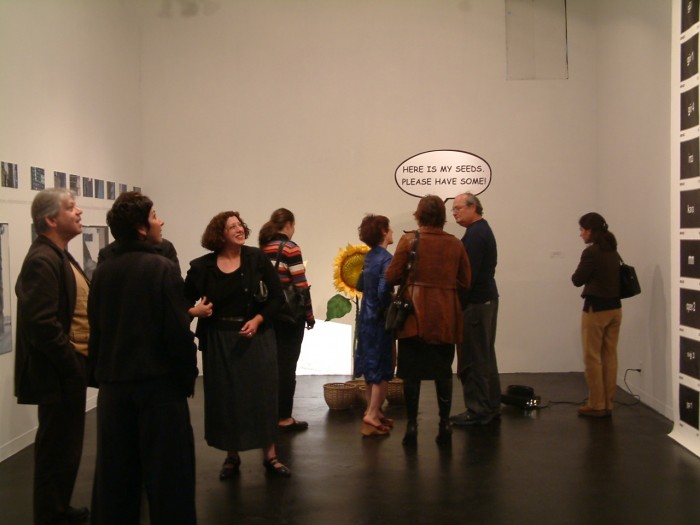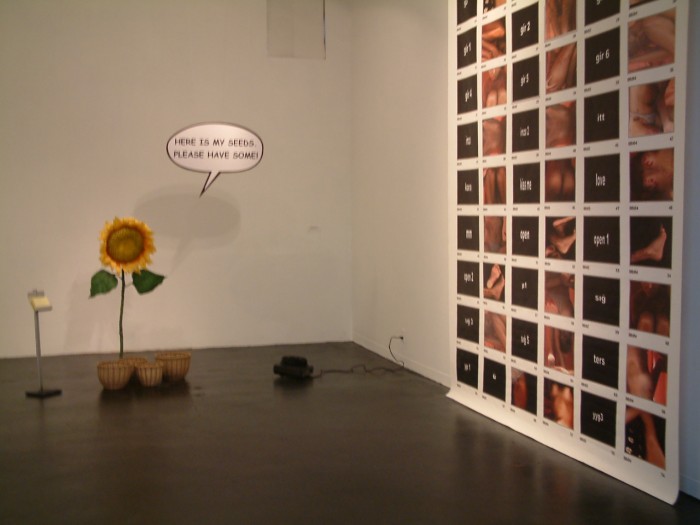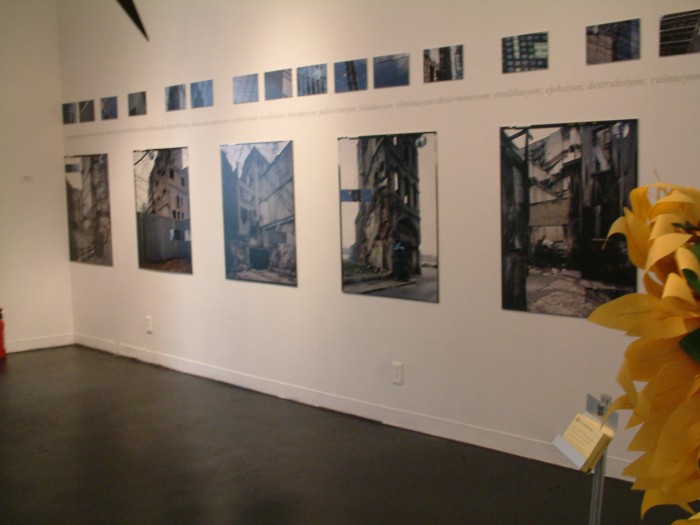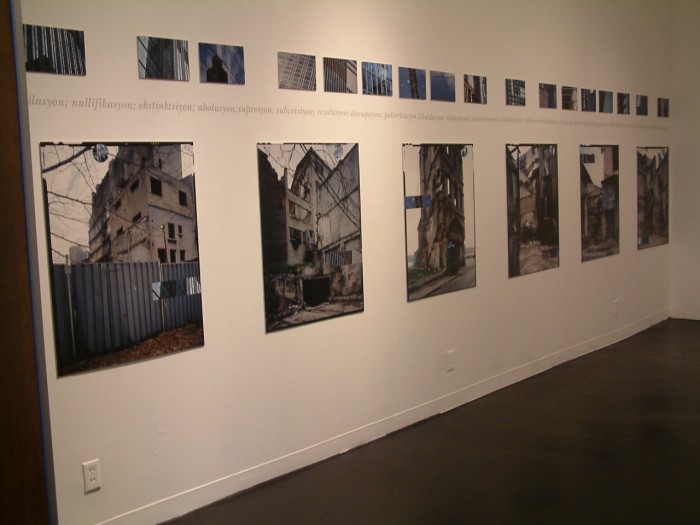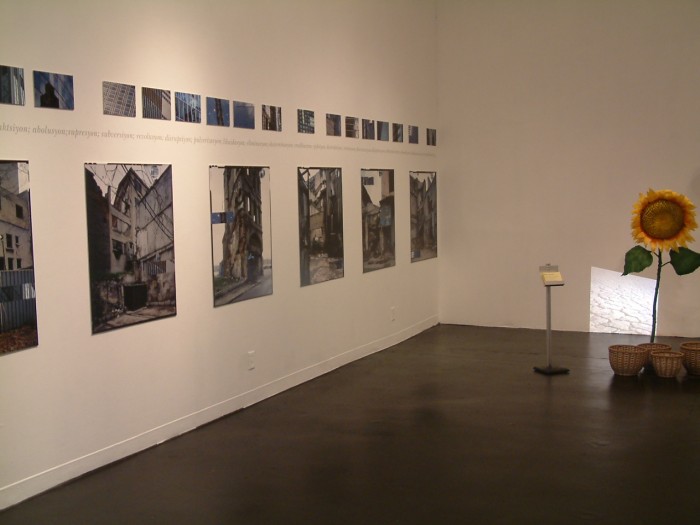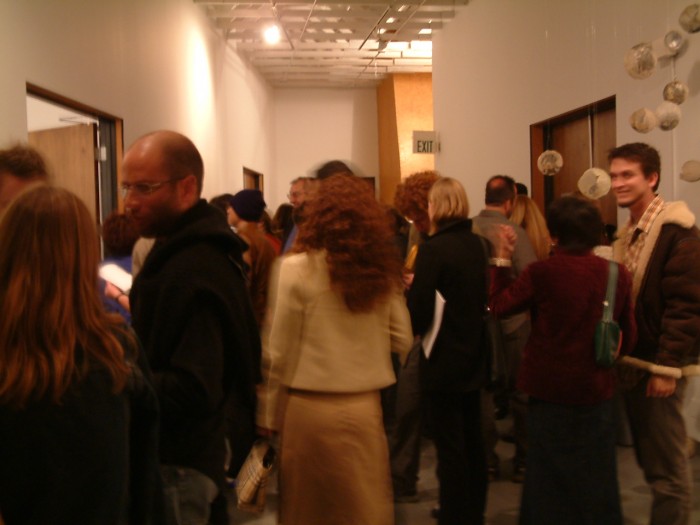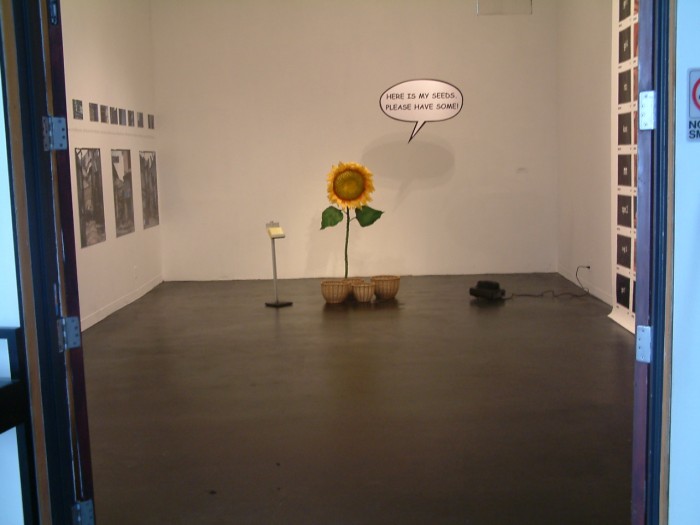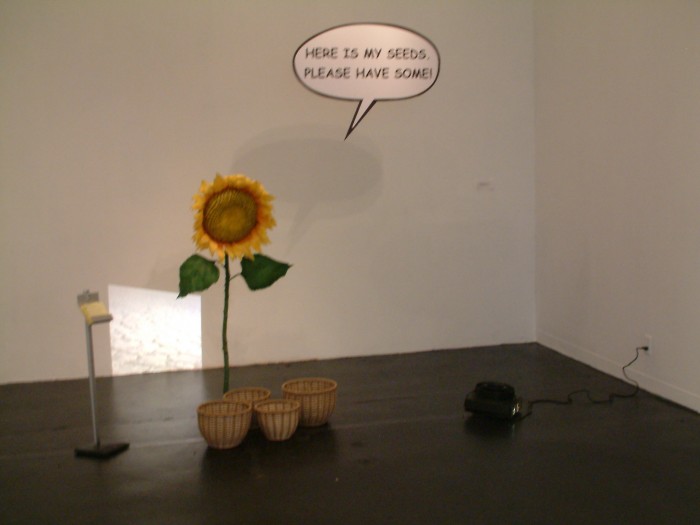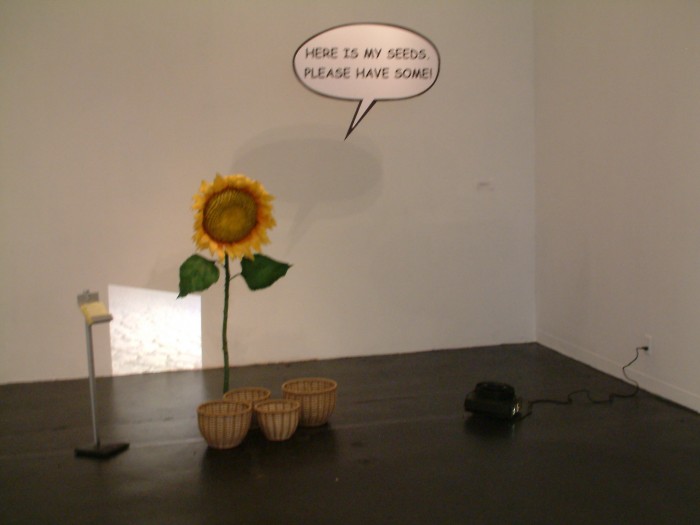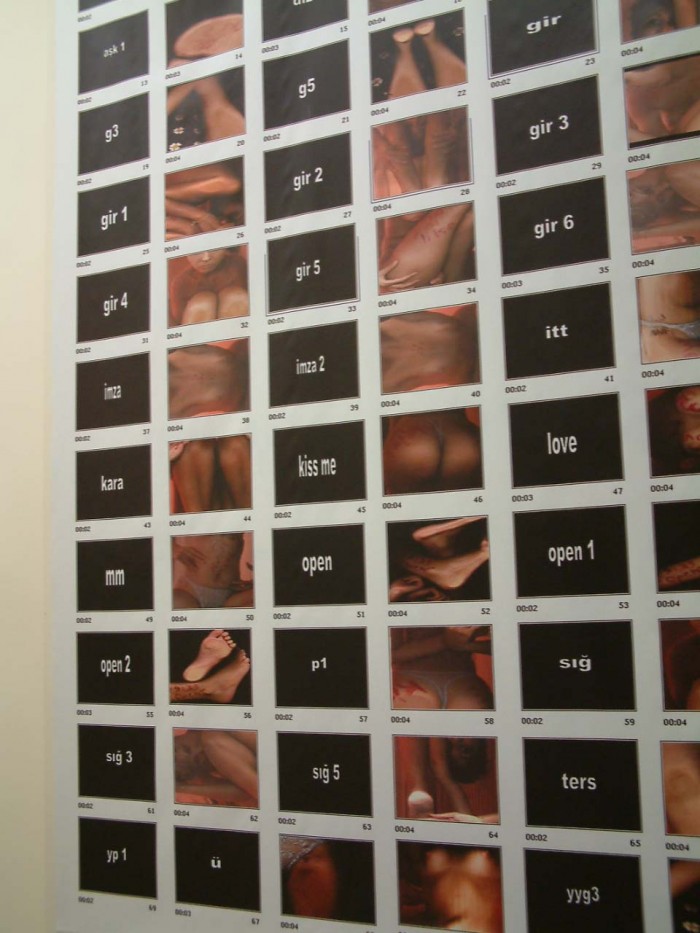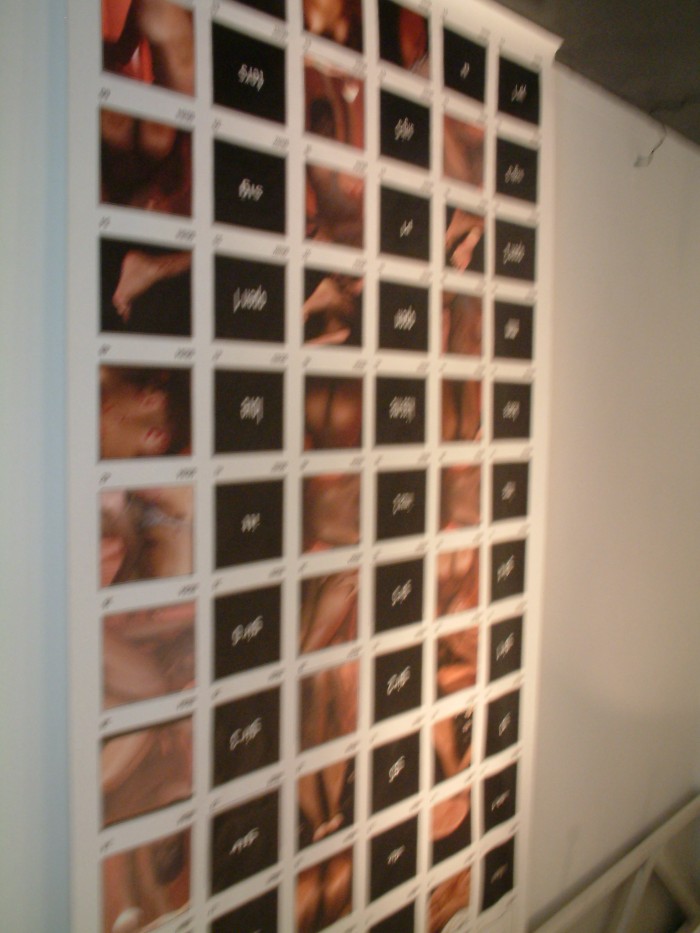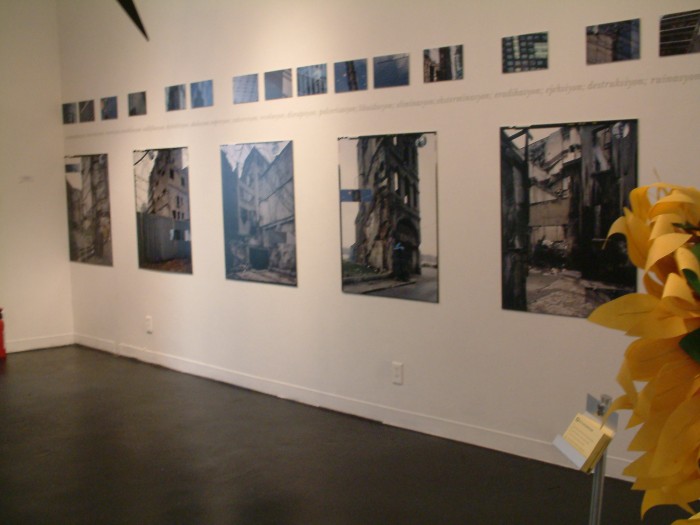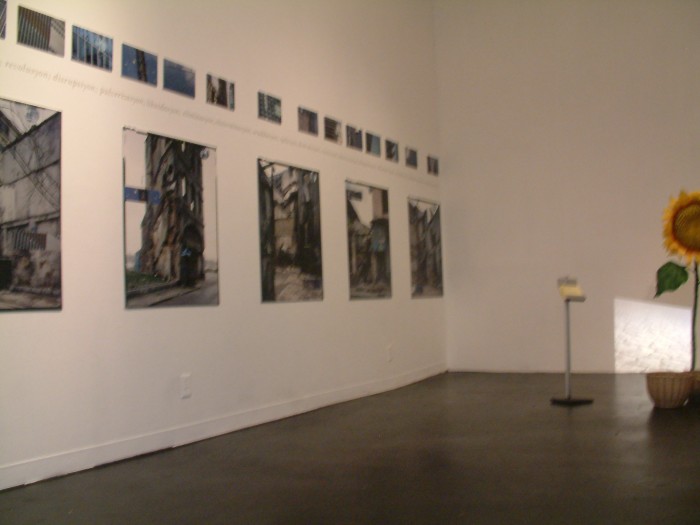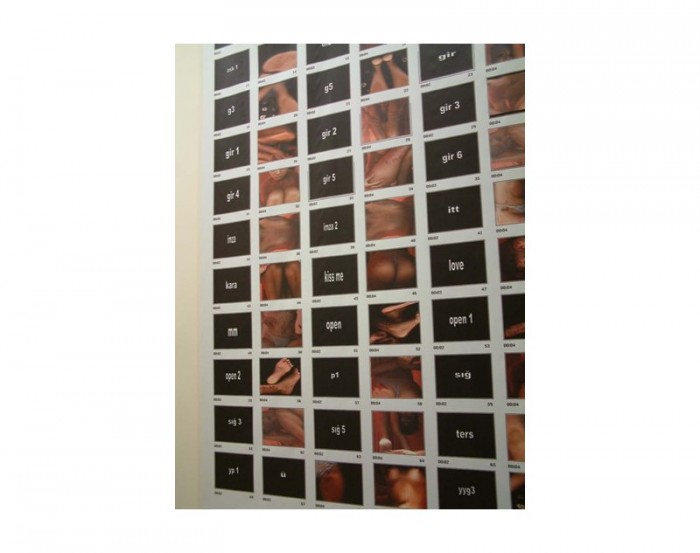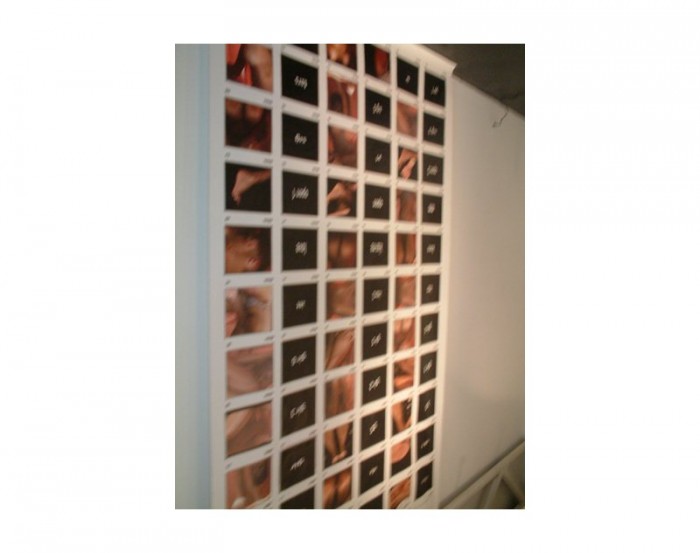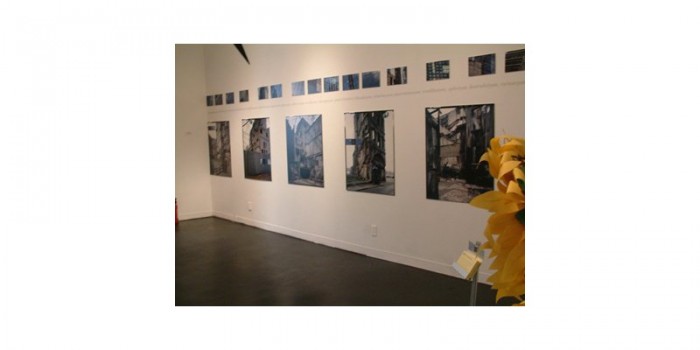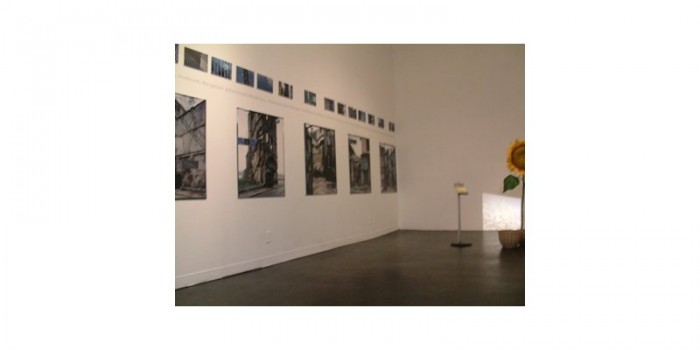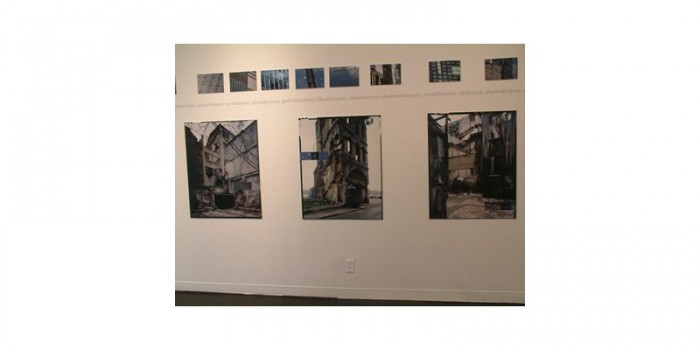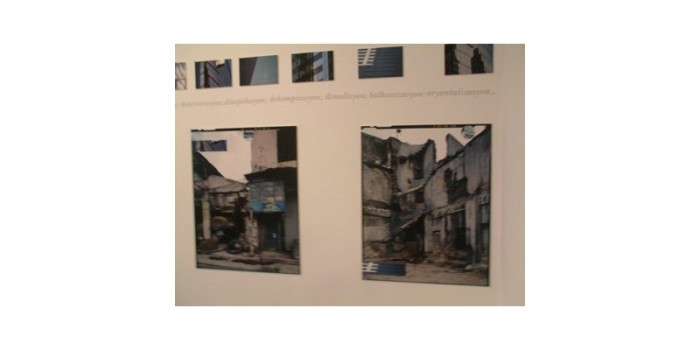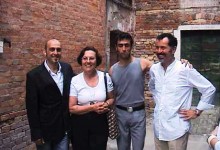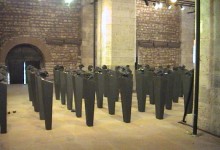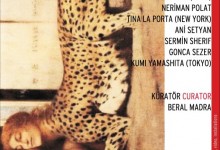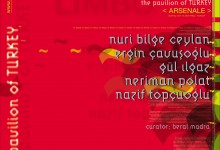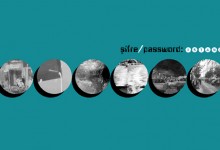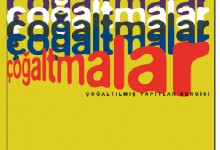Press release
Suture/Rupture
REGISTER THE DISTANCE: ISTANBUL-LOS ANGELES
Crazy Space, Saturday, May 3, 7-9PM
Crazy Space is pleased to announce Suture/Rupture: Register the Distance Istanbul-Los Angeles, an exhibition of four artists from Turkey dealing with intersecting visions and shifting perspectives of cultural identity. Conceived by renowned Turkish curator Beral Madra, Suture/ Rupture, Register the Distance: Istanbul-Los Angeles will be on view from May 3 through May 24, 2003 at Crazy Space and will feature works by
DAMLA HACALOGLU, SEYDA CESUR, XURBAN.NET (HAKAN TOPAL & GUVEN INCIROGLU).
A Reception for the artists is scheduled on May 3, 7-9 PM.
Although the critique of orientalism has had a major impact within the context of western and American art, orientalist representation, and the orientalist evaluation of contemporaray art from the Islamic countries still remains deeply marked by racist legacies. Despite such a depiction of the orient from the western point of view, contemporary artists from Turkey are determined to represent and present themselves in their own terms and to reverse cultural misconceptions by employing seductive and repulsive strategies in their art production.
Located between Europe and Asia, Turkish culture has historically represented states of indeterminacy, oscillating between the orient and occident. This unique position is also the very reason for the many divergent styles and media, different viewpoints, themes and subjects in art production. Being aware of the existing clichés
and the oversimplified representations of their work in the west, Turkish artists approach the Los Angeles viewer with dual concerns. They want to discover the common threads between the two cultures while resisting “the evil eye” ofthe west. To this end, the exhibition will raise many issues: Can we understand artistic
creation in terms of national categories, for instance a “specifically American” or a “specifically Turkish” essence, specifically oriental or occidental? Or is it a more complex process that must be free of oversimplified cliches and shorthand expressions? Rather than providing an answer, the exhibition is designed to provoke
questions by providing a platform to voice the concerns of contemporary Turkish art practices.
Seyda Cesur: Graduated from Marmara University, artist Seyda Cesur participated in many international and national shows, including Mirror of Balkans, National Museum Gallery Kraljevo, Yugoslavia 2002; 10th Asian Biennale, Bangladesh-2002; Reise Durch das Labyrinth, Pozzo Pozozza Gallery,
Kreuzberg,Berlin-1998; New Proposals, New Propositions, Borusan Art Gallery, Istanbul-1998.
Hakan Topal and Guven Inciroglu: Hakan Topal and Guven Inciroglu are the core members of xurban.net (www.xurban.net) an online collective dedicated to art and politics and attempts to motivate/provoke theorical/political discussions and online artworks. xurban net realized many site-specific installations with online
components to circulate through the World Wide Web since 2000. In 49th Venice Biennale Topal and Inciroglu constructed a pool of confession, a collective pool of imagery and deepest secrets, on the web,and actual space. The artists believe
that not only in the order of taboos and sexuality, but through game and mockery, the confessions may bring out the most unspeakable, the most violent desire and the hatred, possibly the hidden fascist in every man and woman of the West and the East.
Damla Hacaloglu: Damla Hacaloglu graduated from CalArts (MFA) and majored in Scenic Design& Integrated Media. Experimenting with intersections of sound
image and movement, Hacaloglu created and performed many interdisciplinary
projects, including Hexagon (2000), Earthquake (1999), Belly Dance (1999) at CalArts, Los Angeles.
Crazy Space, 18th St. Arts Complex 1629 18th St., #2, Santa Monica, CA 90404 One half block north of Olympic For information: (310) 82
Concept
The exhibition from Istanbul designed for Crazy Space in Santa Monica, Los Angeles deals with two facts concerning the geographical, cultural distance between two metropols.
The most profound similarity between these two cities is their past centripetal positions as peripheral territories in reference to the archetypal centres of Europe and USA and to the contemporary art-market and system axis of Berlin-Paris-London-New York. A further common ground is their post-modern centrifugal positions as melting pots of global human movements. Worth mentioning is that both cities are thresholds to the Eastern Civilisations, embracing both ends of the vast territory called Asia and the Pacific.
Evidently, this common ground of evaluation is not enough to cover the continental, oceanic and cultural gap that should be overcome by the artists of Istanbul. However, this complication should not overshadow the concepts and production of the artists, that have exciting uniqueness and pecularity within the heterogenic, distopic cultural and social context of Istanbul.
Therefore, I have designed the exhibition in two components: One component is connected to their inherent/original production; the other to the process of creating a work for Los Angeles.
The main title of the exhibition “Suture/Rupture” refers to the inherent/original production of the artists as well as to the possibility of there work creating a “suture” and “rupture” within the context of the exhibition. Suture is Sewing together or joining of two surfaces, specially of a cut or a wound or it is a line where two bones, specially of the skull join in an inmovable joint or it is the line beetween adjoining parts of a plant or an animal, such as clamshells. Rupture is breaking. Simply, the term is being used in film theory and technique, indicating houting/countershooting during a dialogue of two persons that convinces the viewer to be in the scene. Complicately, the term has been used by Lacan.
Evidently, the viewer will approach the works created by the artists coming from an “unfamiliar” territory in an ambiguous manner. Whether fascination or enticement, or rejection and dismission, in many ways, it is the desire of the viewer to be a part of the event, or to perceive the other gaze, the gaze of the artists or of the other viewer.
Moreover, the art work is not completed without the evil eye of the viewer, which is resolved by multifaceted voyeurism, fetishism or curiosity. Whatever the attitude, here, the dialectic of identification will determine the message of the work. And, this is the prevailing risk the artist is taking on himself/herself by being in a foreign/remote territory, a fact that is not all the time properly taken into account by curators. The reception of the works in remote and unknown exhibition context is very much related to Lacan’s ideas as declared in an interview:
Lacan declares that the suture, is the pseudo-identification, that exists between the time of terminal arrest of the gesture and the dialectic of identificatory haste, which is the moment of seeing. He says: “The two overlap, but they are certainly not identical, since one is initial and the other is terminal. . . . This terminal time of the gaze , which completes the gesture, I place strictly in relation to what I later say about the evil eye. The gaze in itself not only terminates the movement – it freezes it. Take those dances I mentioned – they are always punctuated by a series of times of arrest in which the actors pause in a frozen attitude. . . . The evil eye is the fascinum, it is that which has the effect of arresting movement, and, literally, of killing life. At the moment the subject stops, suspending his gesture, he is mortified. The anti-life, anti-movement function of this terminal point is the fascinum, and it is precisely one of the dimensions in which the power of the gaze is exercised directly. The moment of seeing can intervene here only as a suture, a conjunction of the imaginary and the symbolic, and it is taken up again in a dialectic, that sort of temporal progress that is called haste, thrust, forward movement, which is concluded in the fascinum. (*)
The subtitle refers to the process of developing the work and the exhibition for “foreign” territory and space. Here, my objective and intention is to make this process as natural and inherent as possible. Thinking that the artist as soon as he/she is invited to this exhibition, will mentally be engaged in this task and in his imagination the journey will begin. Precisely this fact should build the formal structure of the exhibition, namely thinking on and creating for Los Angeles in Istanbul. This can be a kind of recording the events between Istanbul and Los Angeles, or a daily journal, or a collection of concepts and theories conceived between now and the opening of the exhibition. Here again, the art work produced within this time limit, between reality and imagination, between absence and presence is a kind of “suture” and “rupture”.
Beral Madra/ December 2002
*Jacques Lacan. The Four Fundamentals of Psychoanalysis. Trans. Alan Sheridan. New York and London: WW. Norton. 1978. 116-
LOS ANGELES’DE ON GÜN
Eğer “dünyada olmak, ama hiçbir yerde olmamak” gibi bir durum varsa, bu uçak yolculuklarında ve havaalanlarında geçirilen zamanı iyi tanımlıyor. Uçak ve havaalanı sanayii insanı sınıflanmış bir mal gibi paketliyor ve bir yerden bir yere naklediyor. Uçak koltuklarının insan sağlığını tehdit ettiği su götürmez bir gerçek; kitle taşımacılığının insafsızlığı da. Bir grup “seçkin” insan uçakların önünde uzanıp yatarken, yüzlerce kişi uçağın arka bölümünde dizleri burnunda oturmak zorunda kalıyor; ve bu durum birkaç yüz dolar daha fazla ödemeye bakıyor. Kapitalizm ve demokrasinin öngördüğü eşitsizliklerden birisi. İnsanların zamanı geçirmek/öldürmek için bir aşağı bir yukarı salındıkları, “duty-free” lere girip gereksiz alış-veriş yaptıkları, plastik sandviçleri kemirdikleri ya da iyice kafayı çektikleri havalanlarında dayatılan ortam da “yokum, çünkü havaalanındayım” dedirtiyor. Burada tuhaf olan, milyarlarca uçak yolcusunun bütün bu paketlenmiş aşağılanmaya karşı çıkmaması; en azından tüketici hakları açısından…
Istanbul-Münih-Los Angeles gidiş, Los Angeles-Frankfurt-Istanbul dönüş saatlerinin özeti böyle.
Los Angeles’deki on günün özetinde ise otoyol/otomobil kültürü önemli bir yer tutuyor. Benim birlikte olduğum insanlar otobüse binmiyordu ve hangi otobüsün nereye gittiğini de bilmiyorlardı; böylece tek toplu taşıma aracı olan ve neyse ki kullanıcılarınınolduğunu gördüğüm otobüse hiç binemedim – Avrupa kentlerinde toplu taşıma araçlarıyla heryere gidilebildiğini düşünce, bu durum bir özgürlük kısıtlaması gibi geldi. Bu kez “otoyoldayım, yokum” gerçeğini içeren otoyol/otomobil kültürünün de iki ögesi var; milyonlarca taşıt (otomobiller ve kamyonlar) ve yollar boyunca uzanan bakımlı yeşillikler. Belli bir hızda hiç durmadan gitmek zorunda olduğunuz yol boyunca size yaşadığınızı anımsatmak için olsa gerek…Los Angeles yollarında ve parklarında 150 cins ağaç var; merak edenler <ahref=”http://www.lacity.org/streettree”>http://www.lacity.org/streettree de ayrıntılı bilgi bulabilir.
Kentin merkezlerini bağlayan yollar boyunca manzara değişmiyor; piramitten yunan tapınağına, gotikten baroka gelmiş geçmiş bütün mimarlık örneklerini çağrıştıran ya da modern, ultra modern, post-modern resmi ve özel binalar, kulübe ya da saray gibi evler küçük alış-veriş merkezleri, sanayi blokları birbirini izliyor. Araya azınlıkların yaşadığı mahallelerin diaspora ya da etnik özellikli mimarisi de sızıyor. Kente yalnız egzotik bir karakter vermekle kalmayan binlerce California ve Meksika palmiyesi de tekdüzeliği tamalıyor; Güney Kalifornia çölünün doğal bitkisi olan bu palmiyeler Los Angeles’in doğal bitki örtüsü değil, kamyonla taşınıp gereken yerlere ekiliyor. Bu, tarihsel mimarinin taklitleri ile oluşturulmuş sahte tarih sürekli bir bellek özlemi uyandırıyor. Elektronik iletişim ve sınırsız sürekli otomotif taşımacılık mantığı üstüne yanyana kurulmuş yapay cennetler de insanı sürekli bir esneklik ve değişim beklentisine sokuyor. Ne bellek ne de değişim gerçekleşiyor; önemli olan mekanın/nesnelerin egemenliği uğruna zamanın tüketilmesi…
Bu uçsuz bucaksız kente biraz olsun yüksekten/uzaktan bakmak için- bir bütünlük duygusu kazanmak için- Holywood’a Mullholland Drive’a ya da San Pedro’ya gitmek ya da Doğu’daki dik dağlara çıkmak gerekiyor; turistik helikopter turu yapmak dışındaki seçenekler bunlar. Düzlükte otoyollarda ilerlerken birkaç kerteriz noktası var; en ihtişamlısı Downtown’daki gökdelen bloğu. Olası bir depremde birbirinin üstüne yıkılmayacak biçimde yerleştirilmiş (ya da statiği öyle hesaplanmış) kırmızı, bej, kurşun mavisi renklerindeki gökdelenler, kentin merkezinde dev bir heykel gibi duruyor. Willshire Bulvarı ve Beverlyhills’deki yüksek binalar da insana hangi yöne doğru gittiğine ilişkin ipucu veriyor.
Los Angeles’e ilk 1991’de, azınlıkların/yoksulların ayaklanmasından birkaç ay önce, ABD AICA’nın (uluslararası eleştirmenler derneği) genel kongresine davetli olarak gitmiştim. O dönemde Los Angeles’te kültür açısından yeni bir yapılanma söz konusuydu; Doğu ABD’ye özgü periferal kültürden postperiferal kültüre geçiş süreci yaşanıyordu. Bu bağlamda, Santa Monica pilot bölge olarak ele alınmıştı; insanlar arasında iletişim sağlanması amacıyla 3rd Street trafiğe kapanmıştı; kafe, restoran ve butikler yanyana diziliyordu. Kültürün odak noktalarından birisi de Frank Gehry’nin uslubunun ilk örneklerinden olan Santa Monica Museum of Contemporary Art’dı. Şimdi, bu tür geleneksel dükkan/ kültür-sanat merkezi yapılanmalarıyla kent merkezini canlandırma projeleri başka mahallelerde de uygulanmış.
Bu kez yolculuğun nedeni, 2002 Agustos’unda aldığım bir e-postaydı. Gül Çağın adlı bir sanatçı, beni internetten bulmuştu ve Los Angeles’te Türkiye’den sanatçılarla bir sergi yapmamı istiyordu. Kısıtlı bir bütçe vardı; bilinen savaş öncesi-savaş-savaş sonrası ortamda Türkiye’de sponsor bulmak olanaksızdı; sanatçılar ve ben kendi payımıza düşen özveriyi kabul etmek durumundaydık. Aralıklı olarak bir kaç ay süren yazışma sonunda karşılıklı güven duygusu, bu serginin zor da olsa gerçekleşmesini sağladı. Santa Monica’da bir kaç yıl önce açılmış bir sanatçı merkezi olan 18th Street Art Complex‘in Crazyspace www.crazyspace.org adlı küçük galerisinde, 3 Mayıs’ta Şeyda Cesur, Damla Hacaloğlu ve xurban.net (Güven İncirlioğlu-Hakan Topal)’ın yapıtlarıyla “Istanbul-Los Angles/ Registering the Distance” başlıklı sergiyi açtık. Sergide Şeyda Cesur‘un, Borusan Sanat Galerisinde Kendi Portresi sergisinde yer alan kendi bedeninin ya da portresinin günlüğü olarak 11 adet tarama (scanning) imge içeren 400x 250 cm ölçüsünde dijital baskısı, izleyicilerin sanatçıya Türkiye sanat ortamının bu imgelere nasıl yaklaştığı konusunda çeşitli sorular yöneltmesine neden oldu. 2000’den bu yana sanal ortamda gerçekleştirdikleri siyasal/toplumsal/kültürel içerikli üretimleriyle tanınan xurban.net‘in Istanbul’un güncel mimari dokusunun karşıtlıklarını gösteren, yıkıntı ve gökdelen fotograflarından oluşan iki dizi arasında yer alan destrüksiyon, abolisyon, anihilasyon gibi yıkım/yokolma anlamındaki türkçe yazılışlı yabancı sözcükler küresel ekonomi ve savaş arasındaki bağlantıyı kuruyordu. CalArts’da sahne tasarımı ve medya masteri yaptıktan sonra bir yıl önce Türkiye’ye dönen Damla Hacaloğlu‘nun seramikten ürettiği büyük ayçiçeği ve arkasındaki çorak toprak görüntüsü, insanın doğa ve kurduğu dünya ile ilişkisine bir gönderme yapıyordu.
Sergi dolayısıyla Los Angeles Weekly’de Peter Frank’ın yazdığı eleştiri ise şöyle:
www.laweekly.com/calendar/picks/index.php/ www.laweekly.com/calendar/picks/index.php
Türkiye’nin Avrupa Asya arasında ve dahası laik ve dinci güçleri arasında köprü kurma çabası, güncel kültürel ürünlere bir keskinlik/acılık katıyor. Register the Distance: Istanbuş-Los Angeles’I oluşturan üç kavramsal yerleştirme, duru, açık güzellikleriyle insanı hemen etkiliyor; hemen algılanabilen biçimsel bir aydınlık yansıtıyorlar. Damla Hacaloğlu’nun büyük yapay ay çiçeği ve kabuklu ayçiçeği nasıl yenir tarifi içeren küçük ay çiçeği festivalinde bir “aptallık” söz konusu; tek başına bir gösteriden çok bir Susam Sokağı parodisine benziyor. Şeyda Cesur’un benden fotografları – ilk kez tarayıcı ile yapılmış olanını görüyorum – psikolojik ve fiziksel bir bunalım yansıtıyor. Hakan Topal ve Güven İncirlioğlu’nun Istanbul’un bir sanayi bölgesinden çekilmiş yıkıntı yapıları ile gökdelenleri karşı karşıya getirmesi çok güncel, yetkin ve deliksiz, ama yine de kırılgan.
Serginin gerçekleşmesini sağlayan Gül Çağın, 1980’lerden bu yana, CalTech’de Materials Science and Technology Materials and Process müdürü, 1999 Feynman Molecular Nanotechnology ödülü sahibi tanınmış fizikçi eşi Dr. Tahir Çağın ve iki çocuğu ile ABD’de yaşıyor. Tiyatro tasarımcısı ve yazar Lauren Hartman ile birlikte Crazyspace‘de sergiler ve gösteriler düzenliyorlar. Yurtdışında yaşayan sanatçılara eğilen çalışmalar yapılmadığı için, Türkiye sanata ortamında adı duyulmamış olan Gül Çağın, 1999-2001 arasında Los Angeles’de University of Southern California’da ve Claremont’da Graduate University’de sanat yüksek lisansı yapmış. 1999’dan bu yana California’da birçok özel ve kamusal galeride sergilere katılmış; 2003’de Huntington Beach Art Center, Angels Gate Cultural Center ( San Pedro), Center for Contemporary Arts (Sacramento), Museum of New Mexico (Santa Fe) ‘de grup sergilerinde performanslı yerleştirmeleri yer alıyor. San Pedro’da Angel’s Gate Kültür Merkezi’nde bir grup sergisindeki işi, onu sergideki diğer sanatçılar yanında farklı bir yere konumlandırıyordu. İnek ya da Dalmaçyalı desenli bir kumaşla (siyah-beyaz) yaptığı bir oturma odası içinde aynı kumaştan giysiler giyerek performans yapıyor. Çağın mimari ve bedeb arasındaki ilişkiyi irdeliyor; mimarinin korku, dehşet, yabancılaşma, yitirme gibi durumları saran/örten bütüncül bir ortam oluşturduğunu düşünüyor…Kumaşın baskın desenleri önplan / arka plan, nesne / beden arasındaki farkı siliyor ve gerçek, yanılsama, normal, düşsel, grotesk arasındaki ilişkileri sorguluyor.
Sanatçı Clayton Campbell tarafından yönetilen 18th Street Art Complex “non-profit” bir kültür kurumu; sponsorlar tarafından destekleniyor ve çeşitli ülkelerden sanatçılara Santa Monica’da yaşama ve çalışma olanağı veriyor. 1969-71 arasında Viyana’da Ernst Fuchs atölyesinde çalışmış, 1980’lerde Hiroshima üstüne, 1990’larda The MapPaintings başlıklı, uyuşturucu trafiği, ırk ayrımcılığı ve ezilen halklar üstüne toplumsal/siyasal resimler yapmış olan Campbell, şimdilerde Los Angeles mezarlıklarındaki antik heykellerin fotograflarıyla bir dizi hazırlıyor.
18th Street Art Complex’de sürekli atölyesi olan Lita Albuguerque‘i (www.litaalbuquerque.com) 1994’de Berlin Senatosu bursu dolayısıyla katıldığım seçici kurulda tanımıştım. Albuquerque’in ailesi Türkiye’li; kendisi 1946’da Santa Monica’da doğmuş, ama 1957’ye kadar ailesi dolayısıyla Paris, Miami, Kartaca (Tunus) arasında gidip gelmiş. 1957’de Taliesin West’de Frank Lloyd Wright ile 1967’de Cadagues’de Marcel Duchamp ile tanışmasına önem veriyor. 1982’den bu yana Pasadena Art Center for Design’da ders veriyor. Albuquerque, 2000’de Millenium için Kahire’ye bir proje sunmuş. Projenin bir bölümünü gerçekleştirebilmiş; çünkü insan üretimini simgeleyen balpeteği deseni ile piramitleri birleştiren kolajı, Yahudi propagandası olduğu gerekçesiyle (balpeteğini yıldıza benzettikleri için) protesto edilmiş. Albuquerque kamusal alanda büyük yapıtlar gerçekleştiren bir sanatçı, son işi de Sacremento’da gerçekleşiyor.
18th Street Art Complex’de atölyesi olan Alex Donis‘in, yine aynı mahallede yeni kurulmuş olan Bergamot Station (eski tren istasyonu) sanat kompleksindeki Frumkin Duval Gallery’deki Heroina başlıklı sergisindeki resimlerinde sanat tarihinin arzu nesnesi olarak kadın, sanatçının ilham kaynağı olan kadın, güncel sanat ortamında kadın iktidarı sorgulanıyor. Kaçıılmaz bellek olarak Rönesas’tan Barok’a birçok resim, sanatçıyı mesleği açısından etkileyen kadınların yer aldığı sahneler olarak yeniden betimleniyor.
Bergamot Station‘da (www.bergamotstation.com) 50 kadar özel ve kurumsal galeri yer alıyor; uzaklığın sorun olduğu kentte, galerilerin bir merkezde toplanması izleyici/alıcı sayısını yükseltiyor. Santa Monica Museum of Art’da Frank Gehry’nin binasından buraya taşınmış (www.smmoa.org). Dekoratif resimlerin satıldığı ticari galerilerin yanında birkaç sıradışı galeri arasında Track 16 Gallery‘de UCLA (University of California) sanat fakültesi yüksek lisans öğrencilerinin yıl sonu sergisi yer alıyordu. Karl Haendel imzalı, Floating Hitler başlıklı kağıt üstüne karakalem desen, serginin en çekici işiydi. Flowers West ( www.flowerswest.com ), Soshane Wayne (www.soshanawayne.com ), Frumkin Duval (www.frumkinduvalgallery.com), Hunsaker/Schlesinger Fine Art gibi tanınmış galerilerde, çeşitli tekniklerde, dekoratif liği ağır basan ya da suya sabuna dokunmayan, buna karşın satılabilir nitelikli işler sergileniyordu.
1 Mayıs’ta, kaldığımız Arkadia’ya 60 mil uzaklıktaki CalArts‘da Türkiye’deki güncel sanat gelişmeleri üstüne bir konferans verdim ve gün boyunca bu yıl mezun olacak Haruku Tanaka (Japon), Miriam Schwenke (Alman), Adria Julia (İspanyol), Gian Martin Joller (İşviçreli), Tomory Dodge (ABD’li)’un atölyelerini ziyaret ettim. Michael Jeremy Handiberg ve Amy Satterthwaite‘nin ortak hazırladıkları The Excange Program başlıklı 44 dakikalık videoyu izledim. . Bu genç sanatçıların işlerinde güncel siyaset irdelemeleri, azınlık ya da yabancı olarak kimlik sorgulamaları, dil ve kültür farklılıkları sorunları/sonuçları, kent ve çevre karşıtlığı gibi içerikler dikkat çekiciydi. ABD’nin şimdilerde sorunlu bir ülke olduğunun bilincinde olmakla birlikte, Los Angeles’in sanat açısından olanaklı ve açılımlı bir yer olduğunun altını çiziyorlardı.
90’ların başındaki ayaklanmada yağmalama yüzünden canlılığını yitirmiş olan Pasadena, yakın zamanda akıllı bir belediye başkanın tarihsel (!) binaları onarılmasını, çarşı caddesinin kalkındırılmasını sağlamasıyla yeni bir kimliğe kavuşmuş. Burada, içinde uzak doğu eserlerinden Rembrandt’ın kendi portresine kadar her şeyden bir örneğin sergilendiği Norton Simon Müzesi (www.nortonsimon.org), The Armory Center for the Arts (www.armoryarts.org) ve Pasadena Museum of California Art (www.pmcaaonline.org) yer alıyor. Pasadena’daki diğer kültür ve sanat odakları da şöyle: Pasadena Culture Net (www.pasadena-culture.net), Pasadena Arts Council (www.pasadenaartscouncil.org), Side Street Projects (www.sidestreet.org), Furious Theatre (www.furioustheatre.org), Newtown (www.newtownarts.org), Pacific Asia Museum (www.pacificasiamuseum.org) , Art Center College of Design (www.artcenter.edu) California Institute of the Arts (www.calarts.edu) ve California State University Los Angeles (www.calstatela.edu). Pasadena Arts Council toplumu sanat ve kültürle ilgilenmeye yönlendiriyor, sanat ve kültür merkezleri arasında iletişim sağlıyor, özel ve kamusal kaynaklardan sanata yatırım yapılmasına çalışıyor.
Downtown’daki klasik modernin kalelerinden Moca’nın (www.moca.org ) hemen yanında Frank Gehry’nin görkemli bir çiçeğe benzeyen alümünyum kültür kompleksi bitmek üzere. Westhollywood’daki Lacma (Los Angeles Eyalet Müzesi) ise Meksika, Ortadoğu ve İslam koleksiyonlarını ve ulusal kültür örneklerini barındırıyor. Yine bu bölgedeki üç özel galeri Lace (www.artleak.org), Ace acelosa@aol.com ve Raid Projects (www.raidproject.org) ilk gezilmesi gereken galeriler. 1978’de kurulmuş ve günümüze kadar 5000 kadar sanatçıyı sergilemiş olan Lace‘de, 6. Istanbul Bienali’nde Darphane’i Amirede bedevi çadırı kuran Chris Burden‘in Small Skyscraper başlıklı yapıtı sergileniyordu. Bu, Türkiye için çadırdan çok daha iyi bir yapıt olabilirdi. 1994’de arazisi üstünde kendine bir atölye yapmak için LA belediyesi ile başı derde giren Burden, imar yasalarında bir boşluk bulunca bu projeyi gerçekleştirmiş. Yasaya göre 3m2 tabana oturmuş 10m yükseklikte düz çatılı bir yapı izinsiz yapılabiliyormuş; Burden, TK Mimarlık grubuyla ortak çalışma sonucu, herkez tarafından kolaylıkla monte edilebilecek, depreme dayanıklı beş katlı bir kuleyi, sergi salonunda yatay olarak sergiliyor.
ABD’deki kıdemli galerilerden birisi olan Ace (New York ve Los Angeles) Willshire Boulevard’da görkemli bir eklektik binanın üst katını kaplıyor ve galeriden çok müzeye benziyor. Burada dört sergi yer alıyordu. 1960’larda neon, cam ve video ile çalışmaya başlayan Keith Sonnier’in (1941) Neon Wrapping Bulbs (1967), Ba-O-Ba (1968-74), Mirror Act III (1969), Live Video (1970), Air -To-Air (1973) başlıklı enstalasyonları neon ışığının yansıttığı yoğun renkler ve bir çizgi olmasına karşın mekanı kapsayan bir ışık saçması açısından yetkin örekler olarak etkisini koruyordu. Sonnier, neon ışığının erotik, ruhsal olarak doyurucu olduğunu düşünüyor. Sanayi malzemeleri kullanarak, tarihi mitolojiyi, kültür kimliklerini görselleştiren ve 1960’lardan bu yanan önemini koruyan Jannis Kounellis’in retrospektifi Ace New York’da yer alırken, Los Angeles’de seçilmiş birkaç işi gösteriliyordu. Diğer bölümlerde ise, 1957 Kalifornia doğumlu Jeff Colson’un işlevsel nesnelerin işlevsizleştirilmesi denilebilecek, tunç, demir, fibercam heykelleri, desenleri ve tualleri , doğu Almanya kökenli fotograf sanatçısı Hans Christian Schink’in hiper-realist otoyol altyapıları fotografları yer alıyordu.
Sanat sahnesinde isim yapmış Türklerden grafik tasarım, fotograf alanında titiz ve incelikli işleriyle tanınan Faruk ve Ayşegül Ulay’ı yakından tanımak olanağını buldum. Holywood filmleri afişlerine imza atan grafik tasarımcısı Emrah Yücel ve sanatçı Arzu Arda Koşar’ın adlarını da burada belirtmek isterim.
Los Angeles’te yerleşik Türkler arasında yaratıcılık alanlarında isim yapmış Türklerden grafik tasarım, fotograf alanında titiz ve incelikli işleriyle tanınan Faruk ve Ayşegül Ulay’ı yakından tanımak olanağını buldum. Faruk Ulay YKY yayınlarından çıkan “Tuhaf İnsanlar Zamanı” ve “Beldeler Kitabı” ile Türkiye’de de gündemde. Yazın ev görsel sanat arasında nasıl ilişkiler kurulabileceğini görmek isteyenler, Ulay’ın web sayfasına bakmalı (bkz. www.locusnovus.com). Daha genç kuşaktan, Holywood filmleri afişlerine imza atan grafik tasarımcısı Emrah Yücel’in yakında adı daha çok duyulacak. Telga Südor Mendi ile Los Angeles-Istanbul deprem ilişkisi üstüne bir yerleştirme gerçekleştiren Arzu Arda Koşar, MÜ Güzel Sanatlar Fakültesi Kadri Özayten Atölyesinden Necla Kahyaoğlu da Los Angeles’e yerleşmiş sanatçılar. Benim tanıma olanağı bulamadığım başka sanatçılar da vardır; ancak dikkatimi çeken, bu sanatçıların bir dayanışma içinde olmamalarıi birbirlerinden kopuk olmaları. Bu, Avrupa’da yaşayan Türkler için de böyledir; kültür ve sanat etkinlikleri söz konusu olduğunda birbirlerinden uzak dururlar. Buna karşın köktenci siyasal/dinsel söylemlerde bir birleşme gerçekleşir. Türklerin diasporası anlaşılan böyle. Ancak, çok merkezli ve parçalanmış dokusu olan Los Angeles’te, farklı sanat disiplinlerinde çalışsalar da, sanatçıların biraraya gelip bazı etkinlikler yapmaları, ilgi ve dikkat çekmek için yararlı bir yöntem gibi göründü, bana…
Sanki, bu uçsuz bucaksız kentin birbirini kesen otoyolları farklı kimlikleri eritiyor; mesafeler ve sonsuz kesişme noktaları tekdüze bir kimlik ağının iskeletini oluşturuyor…
Uzaktan bakıldığında kentin mimari dokusunun mükemmelliği, yoksulluğa ait bir ipucu yakalamanın güçlüğü, her an bir Holywood filminin bir sahnesinin yaşanmasının beklentisi insana hep zaman tünelinden geçip gelecekteki bir tarihte yaşadığı duygusunu veriyor. İnsanların bizim bölgemizde yaşadığımız siyasal/ekonomik bunalımları ve savaş felaketlerini Holywood filmi gibi izlediklerini sanmak işten bile değil. Bu izlenim, ancak diyalog başlayınca silinebiliyor; çünkü gerçeklerden ilk onlar söz etmeye başlıyor…
Beral Madra/Mayıs 2003
TEN DAYS IN LOS ANGELES
“Being in the world, still being nowhere” ―if there is any situation possibly defined in these words; it appropriately defines the time spent on airplanes and at airports. Aircraft and airport industries, bundling passengers as if they were commodities, transport these packages from one place to the other. The threat aircraft seats make on human health is indisputable, as is the inhuman treatment of mass transportation. As the “elite” comfortably stretch out in the front seats, hundreds of people in the back of the aircraft sit their knees on their nose. The difference is in the few hundred dollars of extra payment: another inequality foreseen by capitalism and democracy. Furthermore, the environment presented at airports ―where people stroll up and down the halls to pass time, enter “duty free shops” for some pointless shopping, chew on plastic sandwiches, or drench with alcohol― gives rise to the statement, “I don’t exist, I’m at the airport.” The strange thing in all this is that none of the billions of people bundled as air travellers, objects to these insults; at least as consumers claiming their rights.
So is the brief summary of the hours spent on the way from Istanbul to Los Angeles via Munich, and the return via Frankfurt.
The freeway/ automobile culture, also occupies an important place in the course of the ten-day Los Angeles visit. The people I met neither rode the bus, nor knew of the bus routes, so I could never ride a bus ―the only means of mass transportation, and as I luckily saw, had other users. When one thinks that one can travel use the mass transportation all over in European countries, the situation here seemed like a restraint. The freeway/ automobile culture, which now reveals itself with the reality of “non-existence / being on the freeway,” has two aspects: millions of vehicles (automobiles and trucks) and a belt of well-kept greenery along the roads ―perhaps to remind that you are still alive, where, as a rule you have to drive at a certain speed without stopping… There are 150 different kinds of trees on the roads and in the parks of Los Angeles. Those who want to get detailed information can visit http://www.lacity.org/streettree.
The panorama throughout the streets connecting the city centres is the same. Private or public buildings, homes of different architectures from hut to palace, small shopping malls, industrial blocks that associate with any one of the architectural examples of the past and the present, be it the pyramids or the Greek temples, the Gothic or the Baroque, modern, ultra-modern, post-modern buildings are lined up side by side. Architectures of the Diaspora or the minority neighbourhoods also appear occasionally. The thousands of Californian or Mexican palm trees not only give the city an exotic characteristic, but also complete its unity. These palm trees, the natural flora of the South Californian desert, are not raised here, but brought in by trucks for planting wherever deemed necessary. This false history created by the counterfeits of historical architecture, creates the desire for a persistent memory. The ceaseless artificial paradise, basing itself on the logic of electronic communication and unlimited automotive transportation, leads one to anticipate flexibility and change. Yet, no memory or change ―the point is to consume the time for the sake of the dominance of space and objects…
To view this endlessly immense city from above ―and get a sense of unity― one has to go to Hollywood, Mullholand Drive, or San Pedro, or climb the steep hills on the east. These are the alternatives to a helicopter tour over the city. Driving on the freeway through the plains, there are several points of bearing. The tower block downtown is the grand one. The red, beige, lead-blue coloured blocks, positioned (or better to say their static calculations were made) to provide that they do not collapse on one another in case of an earthquake, tide like a giant piece of sculpture in the centre of the city. The towers on Wilshire Boulevard and Beverly Hills give a hint for the direction you are heading.
My first visit to Los Angeles was in 1991, several months before the revolt of the minority/ needy, upon AICA-USA’ (international critics association) invitation to their general congress. Los Angeles was then undergoing a new cultural construction, a transition from the peripheral culture, unique to Easter USA, to a post-peripheral culture ―Santa Monica was the pilot region. The Third Street closed to traffic to provide a communication among people ―cafés, restaurants, and shops lined up one after the other. One of the cultural focus points in this area was the Santa Monica Museum of Contemporary Art ―one of the first examples of the Frank Gehry style. Today, there are also other projects targeting the revival of the city centre through this kind of traditional shops/ culture and art centres in other districts of the city.
The reason for my visit was an e-mail I received in August 2002. An artist named Gül Çağın found my name on the internet and asked me to make an exhibition in Los Angeles, with artists from Turkey. The budget was limited. The known environment of the pre-war ― war ― post-war period made it difficult to find sponsors in Turkey. The artists and I had to accept our shares of contribution. The mutual confidence we built through several months’ intermittent written correspondence, although difficult, enabled the show. So we opened the exhibition “Istanbul-Los Angles/ Registering the Distance” that included the works of Şeyda Cesur, Damla Hacaloğlu and xurban.net (Güven İncirlioğlu-Hakan Topal), on 3 May, at the small gallery Crazyspace run by 18th Street Art Complex (an artist-run space that was opened few years ago in Santa Monica). In the exhibition, Şeyda Cesur’s work, that consisted of 11 scanned images on 400x250cm digital prints, showing her own body or diary in portrait, also shown in the exhibition entitled Self Portrait at the Borusan Art Gallery, caused the viewers to raise questions to the artist, on how the art scene in Turkey approached these images. In the work of xurban.net, known for their political/ social/ cultural works they create virtually since 2000, non-Turkish words like destruction (destrüksiyon), abolition (abolisyon), and annihilation (anihilasyon) that have entered the language in Turkish letters are used. The words, placed between the two series of photographs that show the tower blocks and wrecked buildings (contrasts of Istanbul’s architectural texture), build a connection between global economy and war. Damla Hacaloğlu, who returned to Turkey one year ago after mastering in stage design and media at the CalArts, in her work of large size ceramic sunflower image with a barren land image behind, referred to the relationship humankind builds between nature and the world it constructs.
Peter Frank’s review of the show in Los Angeles Weekly is http://www.laweekly.com/calendar/picks/index.php#art
Turkey’s efforts in building a bridge between Europe and Asia, furthermore between secular and religious forces bring the current products of culture an acuity/bitterness.
The three conceptual installations that constitute “Register the Distance: Istanbul-Los Angeles” strike one at the first moment, with their clear, visible beauties, and reflect a form enlightenment that can be perceived immediately. Damla Hacaloğlu’s large sunflower and sunflower festival that includes a recipe for eating shelled sunflower seeds, bear a certain “silliness” ―it seems more to be a parody of Sesame Street than a solo show. Şeyda Cesur’s photographs of myself ―this is the first time I see scanned ones― reflect a psychological and physical depression. Hakan Topal and Güven İncirlioğlu’s photographs, that bring the wrecked buildings of Istanbul’s industrial zone face-to-face with the city’s tower blocks, are actual, qualified and imperforate, yet fragile.
Gül Çağın, whom the show owes its existence, is Materials Science and Technology Materials and Process Manager at the CalTech since 1980’s. She lives in the USA with her well-known physicist husband Dr. Tahir Çağın, 1999 Feynman Molecular Nanotechnology award winner, and two children. She and theatre designer and writer Lauren Hartman organize exhibitions and performances at the Crazyspace together. Since exhibitions in Turkey generally do not involve Turkish artists abroad, Gül Çağın’s name is not familiar for the Turkish art scene. Nevertheless, Gül Çağın completed her PhD at University of Southern California in Los Angeles and Graduate University in Claremont between 1999 and 2001. Since 1999, she participated in exhibitions at several private and state galleries in California. In 2003, her performed installations were shown in group exhibitions at the Huntington Beach Art Center, Angels Gate Cultural Center (San Pedro), Center for Contemporary Arts (Sacramento), and Museum of New Mexico (Santa Fe). Çağın’s work, with which she participated in the group show at the Angel’s Gate Cultural Center in San Pedro, puts her in a different place in the show. Her work consisted of her performance she did in the living room she designed with a cow and Dalmatian dog pattern (B&W), wearing clothes of the same material. In this work, Çağın looks at the relationship between architecture and body, and reflects that architecture creates an entire environment that envelops/ conceals states like fright, terror, alienation, deprivation… The dominant pattern of the material she uses effaces the differences between the foreground and the background, the object and the body, and thus inquires about the relationships between reality and illumination, the normal, the imaginary, and the grotesque.
Artist Clayton Campbell manages the 18th Street Art Complex, a non-profit cultural institution. Supported by sponsors, the institution provides the opportunity to live and work in Santa Monica to artists from different countries. I first met Lita Albuquerque (www.litaalbuquerque.com), an 18th Street Art Complex resident artist, in 1994 when I participated in the jury for the Berlin Senate scholarship. Albuquerque’s family is originally from Turkey. She herself was born in Santa Fe in 1946, however travelled between in Paris, Miami, Carthage (Tunisia) until 1957 with her family. She teaches at the Pasadena Art Center for Design since 1982. Albuquerque presented a project to Cairo for the Millennium in the year 2000; however, could actualize only part of the project, because her collage work that combined the honeycomb pattern that represents human production with the pyramids, was protested for the reason that the work made Jewish propaganda (they thought the honeycomb resembled the pentagram). Albuquerque makes large-scale works in public areas; her latest work is in Sacramento.
There are around 50 private and corporate galleries at the Bergamot Station (www.bergamotstation.com) in the same area. In a city where distances emerge as problem, the centralization of galleries increases the number of viewers/ buyers. The Santa Monica Museum of Art also moved its premises here from the Frank Gehry building.
Pasadena, having lost its liveliness because of the pillage following the revolt at the beginning of the nineties, recently assumed a new identity when an intelligent mayor provided for the repair of the historical (!) buildings and the improvement of the market street. The Norton Simon Museum (www.nortonsimon.org), which includes an example of everything from the works of the Far East to Rembrandt’s auto portrait, the Armory Center for the Arts (www.armoryarts.org) and the Pasadena Museum of California Art (www.pmcaaonline.org) are located here. The other focus points of culture and art in Pasadena are: Pasadena Culture Net (www.pasadena-culture.net), Pasadena Arts Council (www.pasadenaartscouncil.org), Side Street Projects (www.sidestreet.org), Furious Theatre (www.furioustheatre.org), Newtown, Pacific Asia Museum (www.pacificasiamuseum.org), Art Center College of Design (www.artcenter.edu), California Institute of the Arts (www.calarts.edu) and California State University Los Angeles (www.calstatela.edu).
The Pasadena Arts Council orients the community for interest in art and culture, builds relationships between art and culture centres, and works to encourage private and public investments in art.
The construction of Frank Gehry’s cultural complex, resembling a glorious flower made of aluminium, right next to MOCA (www.moca.org) ―one of the castles of the classic modern located downtown― is almost complete. The LACMA (Los Angeles County Museum) in West Hollywood, on the other hand, hosts examples of Mexican, Middle Eastern, and Islamic collections, as well as national culture. The three private galleries also in this area, Lace (www.artleak.org), Ace (acelosa@aol.com) and Raid Projects (www.raidprojects.com) are the first galleries one should visit.
The intersecting freeways of this immense city seem to melt different identities; distances and numerous intersection points create the framework of a monotonous network of identities… When viewed at a distance, the perfectionism of the city’s architectural texture, the difficulty in finding a trace of poverty, the anticipation for an experience of a Hollywood film scene any moment, give the feeling that you have travelled through time and live a moment in the future. It is so easy to believe that the people here watch the political/ economic crises and the disasters caused by wars, that we live in our region, just as if they watch the Hollywood productions. This impression changes only after you start talking to people, because it is they who first articulate the reality.
Beral Madra/May 2003
This text is written on the occasion of the exhibition by the artists Şeyda Cesur, Damla Hacaloğlu, Xurban.net, entitled ISTANBUL – LOS ANGELES: UZAKLIĞI KAYDET / “Register the Distance: Istanbul-Los Angeles,” at the “Crazyspace” gallery of the 18th Street Art Complex in Santa Monica, between 3-24 May 2003.

